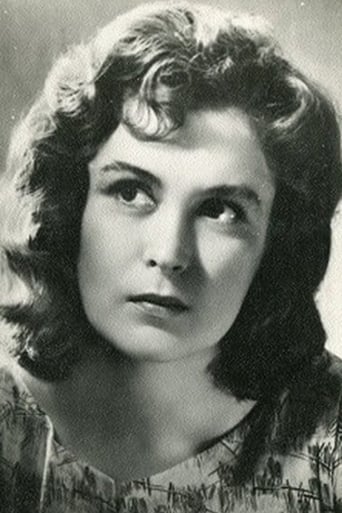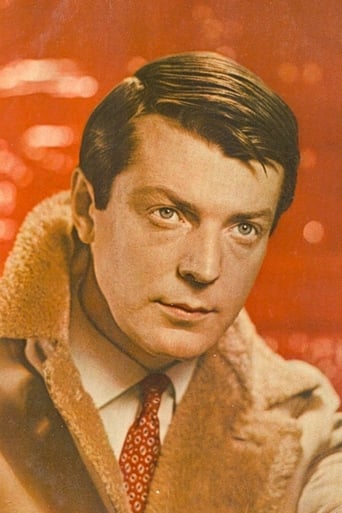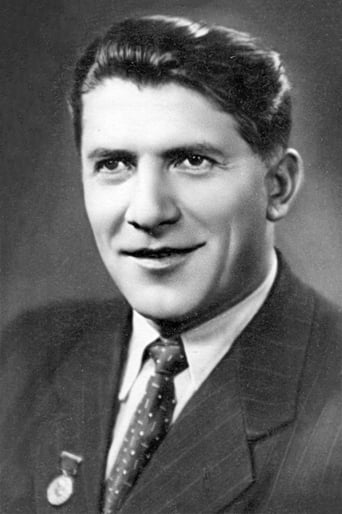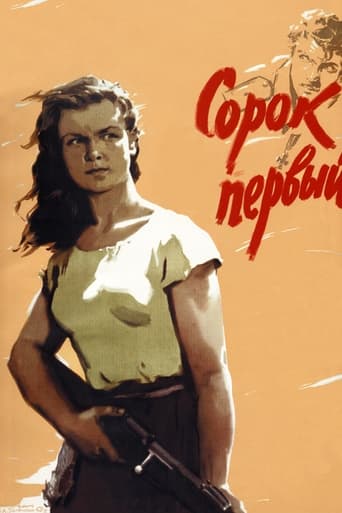
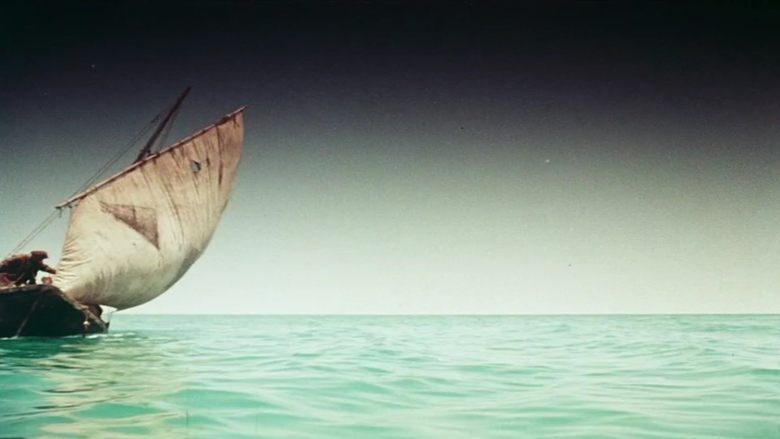
The Forty-First (1956)
An unexpected romance occurs for a female Red Army sniper and a White Army officer.
Watch Trailer
Cast


Reviews
Truly Dreadful Film
Let's be realistic.
A Major Disappointment
It is an exhilarating, distressing, funny and profound film, with one of the more memorable film scores in years,
The feature debut of Soviet Union director Grigoriy Chukhray (who would subsequently acquire international fame for BALLAD OF A SOLDIER in 1959, his second feature), THE FORTY-FIRST is a potentially engrossing romance happens in the two warring parties during the Russian civil war, a Red Army sniper Maria (Izvitskaya) and a White Army officer Lieutenant Vadim (Strizhenov).The storyline is straightforward and linear, based on the eponymous novel by Boris Lavrenyev. Maria is among a defeated Red Army unit, leaded by Commissar Yevsyukov (Kryuchkov), she is a marks-woman, who has already claimed forty lives of her enemies. On their route to retreat in Karakum Desert, the group captures Vadim, aka. the titular forty-first which miraculously survives Maria's bullet, who is carrying a secret oral message to a White Army general, so they keep him as a captive and the Commissar puts him under Maria's guard. When they finally arrives at the Aral Sea, Maria and two other soldiers are entrusted to take Vadim on a boat to their headquarter in Kazaly, but stormy weather causes the boat stranded on a nameless island, and only Maria and Vadim have survived. The seclusion becomes a hotbed for their mutual affection which has engendered throughout their journey to bloom, Maria's nurturing nature, her passion for writing verses and aspiring to acquiring further education and Vadim's erudite knowledge, his "dangerous" blue eyes, bring them closer, not as sworn enemies, but two tender souls, a scintillating paragraph, where they finally embrace and smooch, after Vadim tells her the story of Robinson Crusoe and jokes that she is his "Man Friday". They share the most joyous time on the island, in spite of their ideological disparity of war and life, it is something they must adjust and reconcile for the sake of their love, and at one time, it seems working, they are frank to each other and decide to face the uncertain future together, a happy-ending beckons when a boat is approaching to rescue them, but the climax arrives so abrupt and emotionally manipulative in the coda, when the true identity of the boat is revealed, Maria's almost spontaneous reflex brings a poignant doom to the pair of star-crossed lovers, echoes the portentous title.From the gaping geographical shifting, starts in the desert, to the choppy Aral Sea, terminates on the isolated island, perpetually under an indigo shade, Chukhray emerges as a staunch craftsman in grappling with the diversity of locations, also revels in bestowing an ethnographic touch with its disinterested depiction of Auls people. More bracingly, considering it time, the film is pluckily against the grain of the propaganda exploitation in the Soviet industry at then, humanises the image of a White Army officer, and inspires audience to empathise the genuine affection regardless of their political beliefs, even though the ending could be read as a heroic feat of the loyalty to the Red Army, more resoundingly yet inconspicuously, one cannot help but becoming cognizant of the detrimental power which a radical code of belief can afflict on its subject, to brainwash them, to call on unconditional sacrifice with no bottom-line. Rather than arguing whether the Red or the White serves as the object of Chukhray's admonition, it seems to me, the real deal is the war itself, a diabolical act disguised as a manifestation of patriotism with disastrous outcome, but in essence, only capitalised on by those few warmongers for some elephant-in-the- room self-serving interests, yet, the same thing continues to repeat itself, again and again, no end is in sight. As for the film itself, my admiration is ample and well-grounded.
Grigori Chukhrai's film, The Forty First, sets itself up to be understood as a mythic series of events; the opening scene's churning waves seem to take the viewer away to a different world and the narration sets the story in the post-Revolutionary Civil War. This narration gives the effect of a story being told, and the way the landscape is portrayed creates an unreal landscape. The colors always seem too saturated and the sky hangs close and heavy over the actors, giving the appearance of a fish bowl. Maryutka's inclusion in the plot attests to the Bolshevik ideal of gender equality, making a break with Stalinism's reinstatement of traditional gender roles; her being referred to as an "Amazon" enhances the mythic quality of the film. Chukhrai consciously constructs shots that juxtapose; the scene of Maryutka and the White Army lieutenant walking separate on the beach contrasts the two in space as they both walk in different points of the frame in different directions. The final scenes are obviously ideological: the dialogue is crafted as a metaphor for Tsarist Russia and Communist Russia, with the lieutenant (Tsarism) pleading Maryutka (Communism) to return to how they were before the fighting; the officer's dangling cross necklace is an ever-present symbol of Imperial Russia, designating that even when all visual indicators of partisanship are gone (as he and Maryutka's uniforms have been destroyed by the elements), there is still an irreconcilable difference present. The last scene illustrates the valuation of duty over emotions. Besides the smartly handled ideology, the visual effects are The Forty First's strengths. The color palette and the contrasts it creates are striking, and create a hazy, dreamlike world in which a legend is played out.
The Forty First is a film about two star-crossed lovers who meet a tragic end as a consequence of the time period in which they belong. Set in the years during the Russian Civil War, the film follows Maryutka a red army soldier whose group captures Vadim, a cadet for the white army whom she eventually develops feelings for after connecting with him on a deeper level. The opening credit scenes with its roaring waters and its gloomy music catches the attention of the viewer immediately with its foreshadowing of the tempestuous times to come. The film is more adapted to what films are today so it is easy to become engrossed in it. There are very notable differences in the style of directing within this movie as opposed to the films that were produced during the Stalinist time period. For example, the characters all seem much more individualistic and express their opinions more openly. Of course considering the nature of the film, it being for propaganda purposes, there are still pro revolutionary ideals presented through the unwavering determination that Yevsyukov has to continue for the sake of the revolutionary cause and of course the ending scene in which Maryutka gives the ultimate proof of where her loyalties lie. There is a good use of the space around the characters which turns out to be a great cinematic tool. There are shots of both the arid dessert and the tempestuous sea. It manages to capture both its beauty, as Maryutka noted when comparing it the sea to Vadim's eyes, and its power of destruction when it killed two men and stranded them on the island. The whole storm scene was strategically captured through different angles and distances, further exemplifying the success of this story as a film. Despite the ending which was both astonishing and expected, this film was enjoyable to watch. With all of its elements it ends up being a haunting tale.
The Forty First is pretty much a Soviet Romeo and Juliet. Romance aside, the film offers some praiseworthy elements cinematographically. While detail-oriented aspects of Soviet montage are absent, some long shots of Red soldiers stumbling through desert dunes have a desolate beauty, and scenes in a small Kazakh village are wonderfully authentic. However, bulk of the story takes place in aesthetically blank isolation, where romance and ideology can clash beyond of the confines of armed conflict. Like Chapaev, The Forty First introduces the Whites through a prisoner of war. Unlike Chapaev though, and in a step away from Stalinist film standards, the captured counterrevolutionary lieutenant is unrepentant, and yet still a sympathetic character. The Red and White forces as a whole are depicted in the typical fashion; the Whites as lofty bourgeoisie officers performing acts of unjustified brutality, the Reds as under-supplied and struggling in the face of insurmountable odds. However, the prisoner, Lieutenant Otrok, is merely a wealthy intellectual. Otrok pines for the loss of his pedagogic comfort, not the fall of the monarchical system, and in this sense he is a relatable character. He is apologetic for the conditions that caused the war, and views his captors with good natured derision rather than hatred. We are treated to a well crafted, if utterly predictable, romantic progression as the dogmatic sniper Maryutka, assigned to guard the prisoner, is slowly enchanted by Otrok's charm and intelligence. The film is not a story of bourgeois contamination, though, as Maryutka remains disgusted by the Lieutenant's detachment from the ideological issues of the revolution. The film ultimately determines that regardless of motivation and culpability, the proletariat and bourgeoisie are incompatible. Admittedly, the romantic progression at the center of The Forty First is unremarkable from a modern perspective. However, the film deserves praise for addressing the generally rigid revolutionary genre in a novel and more liberal manner.


